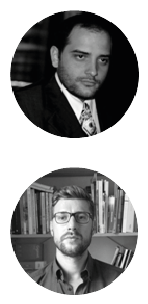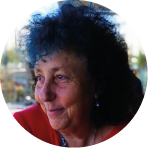UPDATES COMING SOON
PLENARY SESSIONS

13 Maggio 2020 | AUDITORIUM VILLA VITTORIA h.10:00
Innovation Plenary
10.00-10:30: Project Aerariumchain, Giorgio Rea, Aerariumchain Team Leader. PhD in Archaeology at Université Paris-Sorbonne and Università degli Studi di Milano. Experienced archaeologist specialized in research of Roman urban contexts and Roman wall painting. Daniele Buesich, Archaeologist specialized in Roman Provinces, expert in new technologies applied to the investigation and dissemination of Cultural Heritage. For several years he has been adjunct professor at the Brera Academy of Fine Arts (Milan) and at the University of Milan. Collaborates since 2006 with the chair of Archeology of Roman Provinces - prof. M. T. Grassi (Department of Cultural and Environmental Heritage of the University of Milan).

14 May 2020 | AUDITORIUM VILLA VITTORIA h.10:30
European Project Plenary
1o:30-10:55: Project UE STORM, Silvia Boi,Engineering S.p.A., Gabriele Giunta,Engineering S.p.A.,Patrikakis Charalampos,University West Attica, Fabio Perossini,Kpeople ltd, Maria Concetta Capua, University of Tuscia
STORM project was the best opportunity to cope with the challenge of merging computer and communication technologies with human and cultural oriented practices in conservation and restoration. The result of this powerful synergy between these two approaches (technology and CH needs) in view of mitigating effects on cultural heritage, is expected to enormously increase the mitigation of the damages created by climate change disasters. The main question, coming from the experience gained, is how we can capitalize the acquired expertise in the future. This will probably be done using strategies which could rely on local financial support and the possibility to have advanced regulations provided by local authorities. Communication between different actors will play a major role in the future achievements: the project faced a big challenge in establishing good communication among different competences so to say that now, after a three year project, it should be great to start a new experience counting on the level of friendship and communication achieved during the STORM project. But communication is also the key element of emergency management. The recent event which affected the Notre Dame Cathedral (Paris, 15/04/2019), was a matter of discussion between STORM partners and during those discussion we concluded that probably the proper preparedness was not in place. Preparedness could have dramatically reduced the reaction time and the effectiveness of intervention after a disaster. As a final though we are convinced that new professions could grow from the project experience, starting from cultural heritage experts such as conservators, restorers, archaeologists, architects, art historian involving specific branches of engineering; that could create new job opportunities for all those people provided that they will receive the proper education and practice experience. STORM has been a great experience and has increased the awareness on how digital innovation can bring a strong support to the safeguard of our cultural heritage and identity. But Storm is just a start of a wonderful adventure that will hopefully continue with the support of all the involved stakeholders: policy makers, cultural professionals, public authorities, technology and service providers and the entire society.
11:55-11:20: "CD ETA – Collaborative Digitization of Natural and Cultural Heritage" Franca Fauci, Alessandro Monti, Fondazione per la Ricerca e l’Innovazione (Università di Firenze)
The Foundation for Research and Innovation is partner of a five-year Interreg Project “CD-ETA – Collaborative Digitization of Natural and Cultural Heritage”, whose Lead partner is Euroregion Pleven-Olt, a cross border association of the municipalities from Pleven District (Bulgaria) and the municipalities from Olt (Romania).
The partnership is balanced both in terms of regions and competencies of the participating organizations: Estonian War Museum (Estonia); University of Patras (Greece); Foundation for Research and Innovation (Italy); Harghita County Council (Romania); Regional Development Agency of Gorenjska (Slovenia); Association of Municipalities of the Ribera Alta Region, (Spain); Foundation Saint Mary the Royal of Historic Heritage (Spain).
The main objective of the project is to improve the implementation and the adoption of policies on digitization for natural and cultural heritage, through the identification of best practices and the drawing up of 8 Action Plans, one for each member state partner.
The project just concluded its first 3-year phase where the following main activities were carried out:
- Organization of local stakeholder meetings (8 meetings within each participating member state) focusing on digitization of natural and cultural heritage with the involvement of representatives operating in the sector of Culture (local/regional/national Authorities, museums and galleries, libraries, archives, owners of natural and protected areas, institutes, universities, technology companies)
- Organization of Interregional Work Meetings and Thematic Seminars to identify and exchange good practices, thus enhancing cross-border cooperation and capacity building in the sector of digitized cultural heritage.
- Drawing-up of Action Plans, since during this period, each involved partner has hardly worked to lay the basic foundation for his own Action Plan and get the signing by the local policy responsible body.
As far as we are concerned, the Department of Culture and Research of the Tuscany Region signed the document embodying the contributions of the interested stakeholders of the reference territory, which constitutes an operational tool for the development the of the region as a whole. The Tuscany Region, like the other policy responsible bodies of the involved member state partners, will also support the on-going phase 2 of the project, which will last for 2 years.

15 May 2020 | Auditorium Villa Vittoria h. 10:00
International Forum
10:00-10:30: The MirrorWorld, Susan Hazan, Senior Curator of New Media, The Israel Museum, Jerusalem, Expert European Commission, Moderator, Evaluator, Member Council Europeana.
This contribution is a wake-up call to custodians of cultural heritage to get ready and prepare for the next platform – the 3D and 4D experiences of the nascent Mirrorworld. Built upon the first generations of online experience, the sprawling communication platform of the World Wide Web, and driven by the ubiquitous reach of social networks and online gaming, the Mirrorworld will breach the glass ceiling of 2D experiences to draw us into a fully functioning 3D environment. Public institutions that manage cultural heritage for visitors, such as galleries, libraries, archives and museums (GLAMS), are ideally placed to seed the spatial communications network that will drive the new platform. Despite the formidable challenges to be surmounted, it is up to custodians of cultural heritage to become proactive in building the Mirrorworld rather than to wait for third party actors to advance commercial interests with imitation culture, simulated histories, or made-up stories. As gatekeepers of cultural artifacts, GLAMs have the capability, the experience, and even the responsibility to tell their stories forcefully, accurately and in fully-functioning 4D.